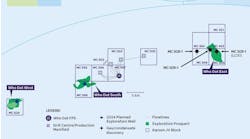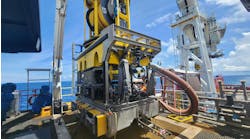Subsea maintenance is under growing scrutiny as operators seek ways of cutting running costs. One approach gaining traction involves use of field-dedicated (resident) underwater drones to undertake inspections or remedial actions on subsea facilities when required. The drones would be operated remotely, from shore or from the host platform, without the need for costly surface vessels and specialist crews and the added complication of COVID-19-restricted travels.
Equinor is leading an initiative on the Norwegian continental shelf that would allow the company (and others) to deploy different types of drones for life-of-field subsea service. All would undergo periodic re-charging and downloading of mission data on seabed docking stations designed and developed by Blue Logic. The ‘open-standard subsea docking station’ – the key to the development as various resident drones are virtually ready for operation – won the innovation award for small and medium-sized enterprises at this year’s virtual ONS event in Stavanger. Over 18 months it has been undergoing underwater trials at test centers in Norway, Sweden, and Italy. If all goes to plan, the first docking station could be ready for commercial service as early as 2022.
Blue Logic, based in Sandnes, southwest Norway, was formed in 2010 by three engineers that had previously worked at subsea specialist Hitec Subsea, where they built and sold seven hiROVs – still considered a high-tech ROV today, according to Helge Sverre Eide, Blue Logic’s Head of Business Development. “But during the 2000s, many companies were building their own ROVs so there was no real market for it.”
They went on to form Ifokus Engineering, developing tooling and interfaces for ROVs, including the actuators that were later qualified for the world’s first subsea gas compression project at Åsgard in the Norwegian Sea. And after selling Ifokus to Oceaneering they founded Blue Logic as an innovator and provider of fluid connection, electrical and mechanical interfaces for subsea equipment. “Within six months,” Eide said, “we had developed a hydraulic connector, and we also produced the first inductive connector on the market. Initially we were frustrated in our attempts to put this technology to work – but that changed when all-electric subsea actuators and control systems began to emerge for different types of underwater drones, little did we know that it would take 15 years.”
Around five years ago, Statoil [now Equinor] issued its target of having a resident vehicle in the water by 2020, and Blue Logic was one of the companies to respond to the call for ideas. Subsequent brainstorming led to discussions with Equinor representatives on the concept of a subsea petrol (gas) station or subsea quay, where underwater vehicles could ‘park’ to re-charge their batteries. Blue Logic drew up a business case for a facility where the docking stations could be built and tested.
Although Equinor was willing to fund the development, the purpose has always been to buy the drone as a service. Tenders went out to all the major ROV players, with Subsea 7 inviting Blue Logic to support its bid after being persuaded that Blue Logic had all necessary components to assemble the subsea charging station in-house. “We built it within one week,” Eide explained.
Equinor wanted an open-innovation approach, with a mechanical interface that could be accessed by different makes, shapes and sizes of underwater drones, and agreed to let Blue Logic manage the program. This led to multiple workshops on the requirements and specifications, attended by Eelume, Oceaneering, Saab, Saipem, Subsea 7, and others. According to Eide, Equinor then agreed to finance an innovation that effectively the whole offshore industry would be able to use, with the interface to be based on Blue Logic’s open innovation.
The open-standard subsea docking station can be lowered by crane from a vessel of opportunity to its permanent location on the seafloor. In its current format the docking station is a flat structure measuring 2.586 x 2.856 m (8.484 ft x 9.370 ft) and supported by API 17D guide posts. But depending on the soil conditions, it could also be placed on a mud mat or held in place via suction anchors.
A combination of two-way inductive subsea charging and communications technologies (including sonar and open-source 3D ChaRuCo) will guide drones to find the docking station in the underwater darkness, with the vehicles’ onboard navigation systems identifying AruCo markers positioned on various parts of the station. Then, during the approach, the docking station’s primary side inductive connectors activate homing mode and the drone detects the magnetic field. As it draws closer to the magnetic field, identification information is received and the correct position in relation to the charging station is verified. The drone itself then enters homing mode and uses the magnetic field to dock precisely onto the inductive connectors, followed by charging of the drone’s batteries and simultaneous upload of mission data (i.e. surveys, inspections, tooling change-outs).
Each docking station will be equipped with containers or boxes that the drones can access to pick up or return different tools, skids, and so on. Charging would typically support 20-50kWh batteries, according to Eide, with downloading of mission data performed simultaneously via 100 Megabit transparent ethernet link. “Capacity of charge is not an issue because with resident drones there is typically a lot of waiting time in between missions.” While Blue Logic would not be involved in supervising charging/download operations, the shore-based team would provide surveillance of the docking station’s condition, i.e. junction box connections in order to guard against short-circuiting, distributing this information via the Cloud for condition monitoring and trending of status. “With regular conductive connectors you cannot monitor the health status. But with inductive connectors, you can monitor the performance over time and predict future issues.”
Blue Logic’s wireless connectors, which supply power and data transmission under water, have been included in the Subsea Wireless Group (SWiG) to define the standardized interface available for use with different communications/positioning systems. The main focus is the acoustics, inductive charging, underwater wireless power transfer, and free-space optics. (SWiG is a network of companies in the oil and gas sector that collectively define standards to ensure interoperability between users of through-water communications technologies). “This means that iXblue, Sonardyne, and others will all be able to connect their equipment,” Eide said, “with no need for us to align with any proprietary solution.” The power/communications interface provides SIIS Level 2 and 3 data transfer rates (230kb/s and 100Mb/s); input power of 100-250 V AC and 145-380 V DC; and software configured output power between 300 and 400 V DC.
The DeepStar consortium of seven oil companies and two subsea contractors is monitoring SWiG’s findings and is also assessing the docking station and monitoring to validate that the open-innovation design complies with its standards, providing confidence to drone suppliers to engineer different solutions on that platform, he added. Blue Logic has helped in the design of the electrical, mechanical and hydraulic interface requirements as part of the 3rd edition of the API 17 standard.
“Since we put this concept on the market in 2016, the only significant change has been to go from a domed to a flat shape for the charging station. We haven’t developed the induction technology any further, although we have developed several applications for the technology without changing the standard. But we are working on making the overall system more robust in order to qualify it for 15 years’ service, operators need that assurance. The process involves agreeing on specifications: as this is brand new equipment, we have to determine what the requirements are for qualification.”
Equinor has already purchased five docking stations, with Blue Logic responsible for defining the specifications for the construction process, and managing the assembly (conducted close to the company’s Sandnes base).
Although various docking stations have already been built to a set design, the concept is fluid with no maximum size. In its current format the station has a total of 22 ports spread across the corners, side and on top along with one fiber communications connector and one power connector: Power and communications can be imported from the surface through an umbilical connection or produced locally. Equinor currently plans to supply power at greenfield locations via an umbilical linked to, but not integrated with, the subsea production system. But there is also scope for using wave or wind energy in future as the power source, Eide said.
Depending on the field layout or drainage strategy, there could be a need for multiple docking stations and drones, he added, notably with longer subsea tiebacks of 10-20 km (6.2-12 mi) or more that might exceed a single drone’s distance tracking capabilities. “Offshore Norway, however, it’s typically very congested, with numerous fields in the same area, so the subsea facilities can collectively share a number of specialized drones.”
Various docking trials have already been performed on the stations constructed to date, one involving Eelume’s snake-shaped drone at the Norwegian University of Science and Technology (NTU) underwater test site in the Trondheim fjord. Oceaneering has tested the wireless charging capability with its new Freedom drone at the Tau Autonomy Center close to Stavanger. Saab conducted trials last year at its underwater center in Motala, Sweden; more recently, Saipem has been testing its Hydrone-R underwater intervention drone, to see how early the vehicle can identify and then track the Aruco markers as it approaches the docking station. Hydrones will be used to inspect and service subsea facilities at Equinor’s redeveloped Njord field in the Norwegian Sea. “All these companies have been testing different levels of autonomy for their vehicles to be able to dock,” Eide explained.
Despite the competition factor, the various participating drone suppliers have been very co-operative in sharing details of their systems with Blue Logic, he added. “This is at present a very limited market and it’s all about developing all the bits and bobs in order to make this an industry. All the companies recognize that for the initiative to survive and prosper, we need to come up with a competitive solution. As for the players not involved, TechnipFMC/Schilling are doing their own thing, although they are following what the industry is doing. Subsea 7’s preference in this case is not to be a leader but to pick up on the learning curve. Ultimately, it’s up to Equinor to assess whether its own priorities are to the people that have done the legwork.
“Fortunately, the development has not been impacted so far by COVID-19. Over the next 18 months the first docking station is due to be installed by Equinor, where results from the ongoing tests will be implemented. Åsgard, Johan Sverdrup, and Njord in the North Sea are targeted as the fields to test the technology. But the schedule for doing this remains on a fly-by basis, when a suitable period allows for the installation.
“Currently we are taking on board the learnings from the trials and the necessary improvements and using these to qualify the docking stations for 15 years of subsea service. As we go, certain tooling requirements will emerge which we haven’t yet thought of. But what will really push this development forward is the low CO2 footprint, with no support vessel needed on site. As the system is fully operable remotely, personnel can handle everything from shore, which is also important in terms of COVID-19 travel restrictions. The development will also lead to improved reliability and regularity in subsea systems.”




